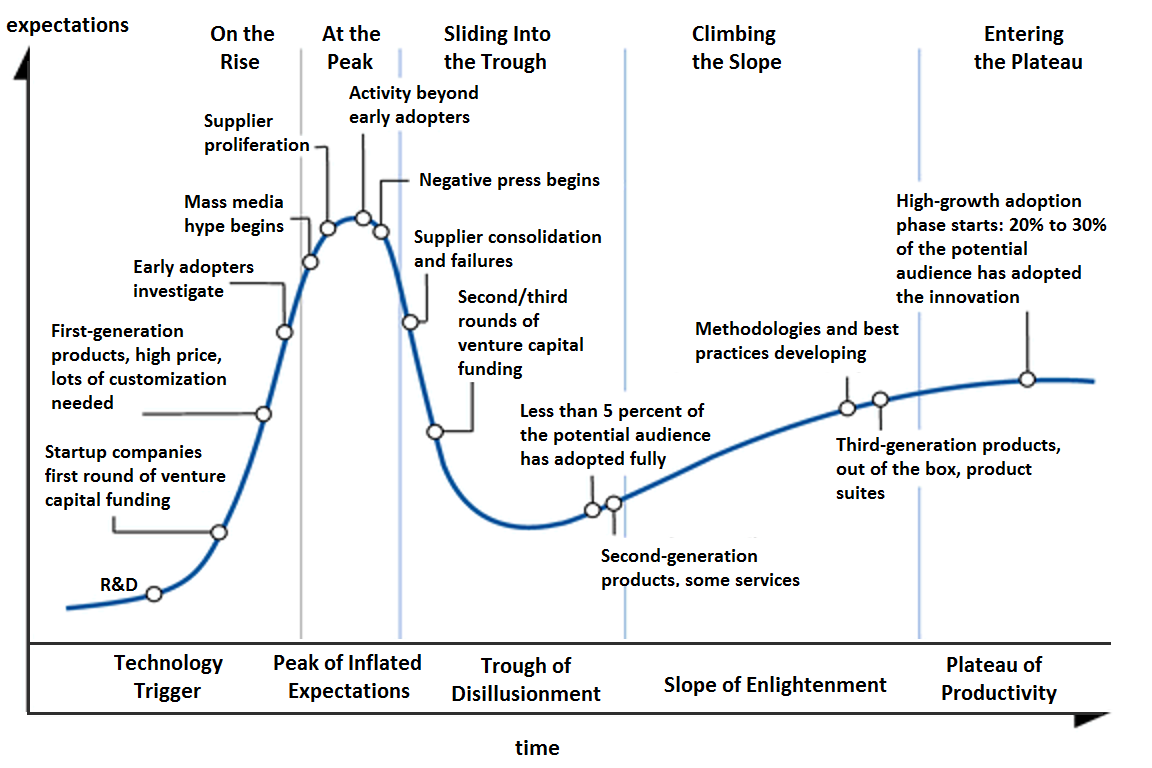AI Hype Cycle: Where are we right now?
July, 3rd, 2025
I’ve always been a fan of Gartner’s Hype Cycle concept. Their model illustrates the typical progression of new technologies, from initial excitement through the “Trough of Disillusionment” (my favorite phase based solely on how catchy the term is), all the way to productive stability in the “Plateau of Productivity” phase - if anything, a nice alliteration. My experience has been that it’s a great visualization to help ground leaders and teams on the state of technologies they’re focusing on and often a sorely needed reminder that there has always been a similar pattern for most every technology brought to the market.
Gartner’s collateral can help you check those vendor statements about the maturity of their products and really get a rounded view of all the adjacent, or in some cases, accompanying capabilities you’re going to have to invest in as well.
Gartner’s Hype Cycle isn’t without it's criticisms - maybe not a scientific approach to tracking technologies, but at its worst it’s a great cataloging of technologies in a given domain and time and their trajectory, including those that fall off next year’s graph before reaching productive use.
As of mid-2025, AI, particularly generative and applied AI solutions, is emerging from the “Peak of Inflated Expectations” and beginning its descent into the “Trough of Disillusionment” where executives are looking at their AI investments and becoming, well, a little disillusioned with what return they’re seeing. This shift isn’t necessarily negative; it indicates technology maturation, confirms the predicted cycle’s path, and urges organizations to sift through the hype to find the value and targeted use cases.
In AI’s case, challenges around data quality, ethical implications, transparency, and regulatory compliance are becoming increasingly visible. Companies are questioning AI’s value and shifting into a value-led agenda for AI.
In other words, reality seems to be catching up to AI (which is good!):
Heightened scrutiny and regulation: Growing demands from regulators and the public for greater transparency, fairness, and accountability in AI systems, particularly regarding bias, privacy, and ethical usage.
Realistic recalibration: Organizations previously dazzled by AI’s potential are adjusting expectations, zeroing in on clearly defined use-cases and realistic ROIs.
Shift toward applied, not generalized AI: Businesses recognizing pragmatic, targeted AI applications deliver immediate value, rather than pursuing elusive goals of artificial general intelligence (AGI).
Practical integration: Firms embedding AI in processes that genuinely improve workflows, aligning human judgment with technological assistance.
Call for refined tools and industry standards: Adoption of comprehensive AI solutions optimized for clarity, effectiveness, full end-to-end lifecycle management, and compliance within specific industry contexts vs a conglomeration of separate vendor applications that “can be integrated.”
Incremental innovation: Companies pursuing continuous, sustainable improvement rather than chasing disruptive breakthroughs - companies understand the path to value isn’t a straight line but now know when to ditch capabilities that aren’t showing promise.
Now, let’s fast-forward this movie a bit: Reality catches up to AI, companies have sifted through the hype, AI becomes even more reliable and internally pervasive at companies of all sizes, vendor offerings consolidate and a compelling minority survive with end-to-end capabilities, and regulation takes hold…but at the same time, AI also becomes something everyone has access to.
MIT Sloan Review recently underscored this critical insight: AI alone doesn’t provide lasting competitive advantage. Because AI solutions become quickly replicable, widely available, cost effective, and the technology itself can’t sustainably differentiate one organization from another. Instead, competitive advantage emerges from how effectively companies integrate AI into their unique workflows, culture, and strategic decision-making processes (MIT Sloan, 2025).
“How can AI be the centerpiece of a sustained competitive advantage when everyone has it?”
In many ways, classic business fundamentals may be the best tool in the shed right now for companies staring down or working through this phase of the hype cycle. Let your strategies be value-led; be objective and data-driven in taking on opportunities AI presents; and believe in the values that got you and your company where it is today. And a word to the wise: AI doesn’t automagically fix your broken process, lack of data quality and governance, or the absence of a structured data pipeline into the AI Factory you dream of building. Get the basic stuff fixed first.
In short, we stand at a critical juncture —> transitioning from unbridled enthusiasm to strategic clarity. For the technologists, futurists, and the academics, AI has been around for a while, but for the general public and companies at large, it seemingly surfaced overnight…and with so much capability, we’re slowed by the thought of real disruption in all parts of our professional and personal lives.
Zoom out far enough and you’ll see robotics and AI converging to solve supply chain labor demands, “co-pilots” taking on a lot of white collar tasks, agentic AI positioning to take on any business workflow and decisioning imaginable, and more recently, CEO’s being more and more public of the impact they see. It’s a dizzying time, to say the least.
AI presents as a different kind of technological advancement than most have witnessed in their lives or even read about. The Internet democratized information and AI seems to be on the verge of democratizing knowledge…and the pace at which things are changing is genuinely hard to keep up with, even for the initiated.
If you’re interested in breaking down the hype for your organization, reach out to us to learn more about our AI Readiness Assessments.

